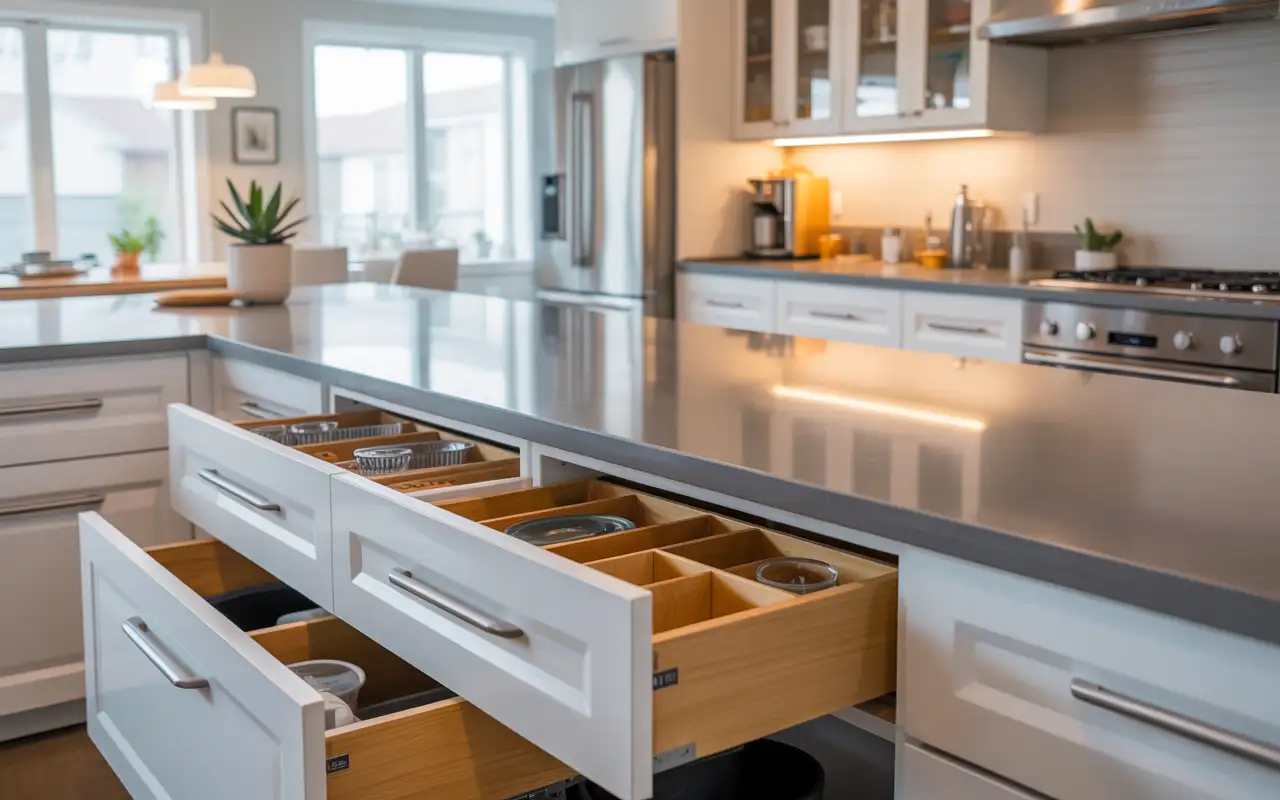That old varnished dresser in your bedroom might look dated, but it doesn’t have to stay that way. Many homeowners feel stuck with dark, glossy furniture and wonder if they can give it a fresh coat of paint. The good news? You absolutely can transform varnished wood with paint when you follow the right steps.
Can You Paint Over Varnished Wood? Yes, but you need to prepare the surface correctly for it to work. Your paint will start to peel off in a few weeks if you don’t clean, sand, and prime it first. This guide shows you how to get a professional-looking finish that will last for years.
What is Varnished Wood?
Varnished wood has a clear, protective coating that seals the surface. This glossy layer protects against moisture, scratches, and daily wear. You’ll find varnish on kitchen cabinets, antique furniture, doors, and trim work throughout older homes.
Not sure if your piece has varnish? Here’s a quick test. Dip a cotton swab in acetone and rub a hidden spot on the wood. If the finish turns sticky or soft, you’re dealing with varnish. If nothing happens, the wood likely has polyurethane or another type of sealer.
Varnish creates a hard, glass-like surface that paint struggles to grip. That’s why painting over varnished wood requires more prep work than painting raw lumber. The glossy finish must be dulled down before paint can bond properly.
How to Tell If Your Finish is Varnish (The Quick Test)
Before you start any project, it is helpful to know exactly what you are dealing with. The best way to identify varnish is with a simple solvent test.
- Dab a cotton swab or a clean cloth into a small amount of acetone (nail polish remover) or denatured alcohol.
- Find an inconspicuous spot on the wood like the underside of a table or inside a cabinet door and rub the finish gently.
- Varnish: If the finish softens, becomes sticky, or turns tacky, it is likely varnish or polyurethane.
- Shellac: If the finish dissolves quickly, it is likely a shellac finish (which is also varnish, but solvent-based).
- Lacquer: If it dissolves very quickly and can be wiped away, it is likely lacquer.
Knowing this confirms you must use a high-adhesion primer, which is the cornerstone of how to paint over varnished wood successfully.
Can You Paint Over Varnished Wood?

Yes, painting over varnished wood is possible and quite common. Thousands of homeowners refresh old furniture and cabinets this way every year. The key is breaking through that shiny barrier so paint can stick.
Many people assume you need to strip varnish completely before painting. That’s not true. With the right primer and paint, you can cover varnished surfaces without removing every trace of the old finish. However, skipping the prep steps will lead to disaster. Paint applied directly to glossy varnish will chip, peel, and look terrible within months.
The process takes time and patience. Plan to spend a full weekend on a medium-sized furniture piece. Rushing through the steps ruins the final result. But when done correctly, painted varnished wood can look just as good as professionally refinished pieces.
How to Paint Over Varnished Wood

Follow these steps for painting on finished wood that looks professional and lasts.
Step 1: Clean the Surface Thoroughly
Start with a deep clean. Varnished surfaces collect dust, grease, and grime that prevent paint adhesion. Mix warm water with dish soap and scrub the entire piece with a soft cloth. Pay extra attention to handles, corners, and carved details where dirt hides.
For kitchen cabinets, use a degreaser. Cooking oil builds up over time and creates an invisible film. Regular soap won’t cut through this layer. Let the surface dry completely before moving to the next step. Any moisture trapped under the primer causes bubbling later.
Check for damage while cleaning. Look for deep scratches, dents, or loose joints. Fill cracks with wood filler and let it dry overnight. Sand the filled areas smooth before continuing. Starting with a solid surface prevents problems down the road.
Step 2: Sand Away the Gloss
This step matters most when painting sealed wood. Grab 120-150 grit sandpaper and work in the direction of the wood grain. Your goal isn’t removing all the varnish. You just need to dull the glossy finish so the primer can grab hold.
Sand every surface you plan to paint. Don’t skip hard-to-reach spots like corners or decorative grooves. These areas show first when paint starts peeling. The wood should feel slightly rough when you run your hand across it.
After sanding, vacuum up all the dust. Use a brush attachment to get into crevices. Then wipe everything down with a damp cloth. Let the surface dry for 30 minutes. Even fine dust particles can ruin your paint job, so take time with this cleanup.
Some people ask about light sanding versus heavy sanding. Light sanding works fine for varnished woodwork in good condition. You only need to scuff the surface, not sand down to bare wood. Save your energy for the painting steps.
Step 3: Apply Quality Primer
Primer makes or breaks your project when painting over varnished woodwork. Choose oil based paint primer for the best adhesion. Oil-based primers seal the wood and prevent bleed-through from the old finish. They smell strong, so open windows and use fans for ventilation.
Apply primer with a brush or roller, depending on your furniture size. Brush works better for detailed pieces with lots of curves. Rollers speed up the process for flat surfaces like cabinet doors or tabletops. Use thin, even coats instead of one thick layer.
Let the primer dry for 24 hours before painting. Check the manufacturer’s instructions on the can for exact timing. Temperature and humidity affect drying time. Cool, damp weather requires longer waits between coats.
If you see brush strokes after the primer dries, don’t panic. Light sanding with fine-grit paper smooths them out. Wipe away the dust and you’re ready for paint.
Step 4: Apply Your Paint Coats
Now comes the fun part. Stir your paint well before opening the can. Pigments settle at the bottom and need mixing for consistent color. Apply the first coat in thin, even strokes. Thick paint drips and leaves visible brush marks.
Two coats usually provide full coverage when painting on top of varnish. Let the first coat dry completely before adding the second. This usually takes 4-6 hours, but overnight drying gives better results. The paint surface should feel dry to the touch, not tacky.
Watch for drips as you work. Catch them immediately with your brush. Once paint starts drying, going back over it causes more problems than it fixes. Work in sections and maintain a wet edge to avoid lap marks.
Step 5: Add a Protective Topcoat (Optional)
A topcoat extends the life of your painted furniture. It adds an extra layer of protection against scratches, moisture, and daily use. Choose between matte, semi gloss, or high-gloss finishes based on your style preference.
Apply two thin coats of sealer with 4-6 hours drying time between them. This step works especially well for high-traffic pieces like kitchen cabinets or dining tables. The topcoat makes cleaning easier and prevents paint from chipping at edges and corners.
What Kind of Paint Should You Use on Wood That Has Been Varnished?
Both oil based paint and water-based options work for varnished surfaces. Your choice depends on the look you want and where the furniture lives.
Oil-based paint provides extremely durable results. It levels out smoothly and hides brush strokes better than water-based formulas. The downside? Strong fumes and longer drying times. You need good ventilation and patience. Cleanup requires mineral spirits instead of soap and water.
Water-based latex paint offers easier application and cleanup. It dries faster than oil-based options, letting you complete projects quicker. Modern formulas have improved significantly and now rival oil-based paints for durability. They produce fewer fumes, making them better for indoor projects.
For kitchen cabinets or bathroom vanities, consider moisture-resistant paint. These specialized formulas handle humidity better than standard paint. They prevent peeling in damp conditions.
Aerosol spray paint for wood provides another option for small furniture pieces. Spray paint creates a smooth, factory-like finish without brush marks. However, it requires multiple thin coats and proper technique. Practice on scrap wood first if you’ve never used spray paint before.
Chalk paint has become popular for furniture makeovers. It sticks to most surfaces with minimal prep work. However, chalk paint works best on decorative pieces, not high-use furniture. The finish scratches more easily than traditional paint.
What Happens If You Paint Over Wood That Has Been Varnished?
Skipping preparation leads to quick failure. Paint applied directly to glossy varnish can’t form a proper bond. Within weeks, you’ll see peeling at edges and corners. The paint lifts off in sheets with minimal pressure.
Temperature changes make poor adhesion worse. Wood expands and contracts with humidity and heat. When paint isn’t properly bonded, these natural movements cause more peeling and cracking.
You’ll also notice an uneven finish. Paint settles differently on slick varnish compared to properly prepared surfaces. The result looks blotchy and unprofessional. Some areas might seem fine while others show the old finish through the new paint.
Proper preparation prevents all these problems. The time spent cleaning, sanding, and priming pays off with a finish that lasts five to ten years or more. Shortcuts now mean redoing the entire project within months.
Can You Remove Varnish Without Sanding?
Yes, but these methods require caution and proper safety gear. Chemical strippers dissolve varnish without sanding. Apply the stripper according to product directions, wait for the varnish to bubble, then scrape it away with a putty knife. This process works well for furniture with intricate details that are hard to sand.
Heat guns offer another option. The heat softens varnish so you can scrape it off. Move the heat gun constantly to avoid burning the wood. This method takes practice and patience. Work in small sections and wear heat-resistant gloves.
Both methods require excellent ventilation. Chemical fumes and heated varnish release harmful vapors. Work outdoors when possible or use respirators designed for paint stripping. Regular dust masks don’t provide enough protection.
After removing varnish with chemicals or heat, you still need to sand lightly. This smooths the surface and removes any remaining residue. The good news? You’ll spend less time sanding than if you skipped the stripper entirely.
For most DIY projects, sanding remains the easiest and safest method. Chemical strippers add expense and require careful handling. Unless you’re working with carved furniture or hard-to-reach areas, stick with sandpaper.
Allow San Diego Home Remodeling To Do The Painting For You
DIY painting projects require significant time and effort. Between prep work, drying time, and multiple coats, a single furniture piece can consume an entire weekend. Kitchen cabinet projects often take two weeks or more.
Professional painting services in San Diego handle all the tedious prep work for you. San Diego Home Remodeling brings years of experience to every project. Our team knows which primers work best for different varnish types. We understand how temperature and humidity affect drying times. This expertise prevents common mistakes that ruin DIY projects.
We also have professional-grade equipment. Our sprayers create perfectly smooth finishes without brush marks. Commercial sanders speed up prep work while maintaining quality. These tools cost hundreds of dollars for equipment most homeowners use once.
Professional painters work faster without sacrificing quality. What takes you two weekends, we complete in days. You get your space back quickly with zero stress. No more living with furniture scattered across your garage or eating takeout because your kitchen is torn apart.
Our warranty backs every job. If paint peels or problems develop, we fix them at no charge. DIY mistakes mean buying more supplies and starting over. Professional work gives you peace of mind and guaranteed results.
Contact us for a free estimate on your next painting project. We handle everything from single furniture pieces to complete kitchen cabinet refinishing. Let us transform your varnished wood while you spend your weekend doing something you actually enjoy.
Frequently Asked Questions
Do I have to sand varnished wood before painting?
Yes, you must scuff sand on the surface. While you do not need to remove all the varnish, you must create a dull, scratched surface (a “key”) for the primer to grab onto. Skipping the light sanding step guarantees that the paint will chip or peel over time due to poor adhesion.
What grit sandpaper should I use for painting over varnish?
Start with 120-grit to 150-grit sandpaper for the initial scuff sanding. After you apply the primer, use a much finer 220-grit or 320-grit to gently smooth out any brush strokes before applying your final paint coats.
What is the best primer to use for painting on finished wood?
The best professional choice is a shellac-based primer (like Zinsser BIN). It offers the strongest bond to slick surfaces and superior stain-blocking capabilities. High-quality oil-based primer is a reliable second choice. A standard latex primer is generally not recommended as it risks poor adhesion to the glossy varnish.
Can you paint on top of varnish using just chalk paint?
Chalk paint is known for its ability to stick to many surfaces with minimal prep. While you can skip sanding, professionals still advise a deep cleaning and a light scuff sanding, even with chalk paint, to ensure the best long-term adhesion and prevent early peeling/chipping. Always seal the final chalk paint with a wax or topcoat for durability.








